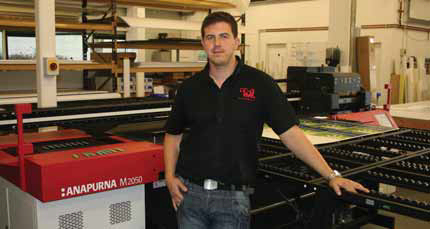The Creative Place explains the significance of its AGFA Anapurna M2050 purchase.
In 2012 The Creative Place turns 20. Since its inception the company has seen plenty of change and now provides full creative, artwork, digital photography, large-format print production and installation, and four-colour printing (including short-run digital) from its purpose built facility in Watford. Yet, as a provider of design and branding solutions, the company was aware that it was not able to directly deliver all the requirements of a marketing communications campaign.
In particular, a lot of the large-scale display graphics requiring direct-to-media printing needed to be outsourced which meant it was less competitive from a price perspective and had limited control over quality and service. So in September 2011 it bought an Agfa Anapurna M2050 so it could handle more customer solutions in-house.
“We have lots of great customers and we want to be able to give them a top quality solution for all of their requirements. Without a large direct to media printer, we simply couldn’t do this and so we made the decision to make what was a serious investment in a new machine,” says James Hunt, production director, who then turned to GPT for direction. “We operate throughout the UK and around the world and have a specific emphasis on continual investment in people and technology. We have worked very closely with GPT for a number of years and value the help and advice they have given us,” explains Hunt. The outcome was the installation of the Anapurna M2050, which had an immediate and positive effect on business.
“We did a lot of promotion work for a particular TV programme. Another company had produced some A1 posters for them but the quality was not good. The supplier said this was the best they could manage with the files provided. We printed the same files on the Anapurna and the quality was much better. Our client loved them and we got the rest of the poster business for that campaign. This was exactly the reason for purchasing the printer and we expect many more examples of this over the coming months,” says Hunt. The Creative Place first looked at an Agfa Anapurna on GPT’s stand at Sign and Digital UK 2011. “It was a combination of the support and guidance of GPT, coupled with the sheer quality of the printer that got to us,” Hunt explains. The Anapurna M2050 is a UV-curable inkjet system with flatbed and roll-to-roll feeding capabilities that can print at production speeds of 24m2/h on substrates up to 2m wide and 45mm thick. A key feature is its white printing function. “This was the absolute latest technology in UV-curing and this is something that is very important to us and gives us a key edge in a hugely competitive market. The print quality, speed and the build of the printer were all top draw. However, the most important factor in our decision was probably the white ink function, which was much more advanced than anything else we saw. The Anapurna has two white printheads, which allows it to lay white ink down before and after the colour inks. Other printers we saw can only do one way or the other and so requires an extra pass, adding time and cost to the printing process,” he says.
Hunt continues: “We were also very keen to have the 2m model so that we could meet even more of our customers’ requirements. We didn’t want to have to compromise in any department. We have customers asking for 2 x 4m banners, which we can now turn around in a few hours. When we had to outsource this printing, we couldn’t do it in less than four or five days.
“Another feature that has already generated us some revenue we would not otherwise have got is the ability to print double-sided with reliability and accuracy. We received a job to deliver 80 double-sided foamex display panels and the quality and speed of the Anapurna has helped us to win this business and deliver it profitably. The difference between doing this job on the Anapurna, compared to a solvent printer was huge in terms of time savings. We are able to print the images on 2x4m panels and then simply flip them over and run them through again, secure in the knowledge that they are in exactly the right place. This took around five hours to complete the whole job and pack it off to the client. On a solvent printer this would have taken at least 18 hours.”


